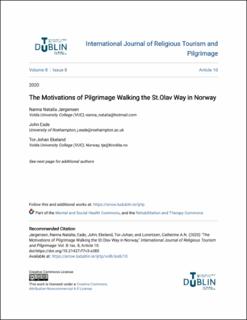| dc.contributor.author | Jørgensen, Nanna Natalia Karpinska Dam | |
| dc.contributor.author | Eade, John | |
| dc.contributor.author | Ekeland, Tor Johan | |
| dc.contributor.author | Lorentzen, Catherine Anne Nicole | |
| dc.date.accessioned | 2021-03-15T09:24:35Z | |
| dc.date.available | 2021-03-15T09:24:35Z | |
| dc.date.created | 2021-01-13T15:29:59Z | |
| dc.date.issued | 2020 | |
| dc.identifier.citation | Jørgensen, N. N., Eade, J., Ekeland, T. J., & Lorentzen, C. A. (2020). The Motivations of Pilgrimage Walking the St. Olav Way in Norway. International Journal of Religious Tourism and Pilgrimage, 8(8). | en_US |
| dc.identifier.issn | 2009-7379 | |
| dc.identifier.uri | https://hdl.handle.net/11250/2733322 | |
| dc.description.abstract | Walking pilgrimages are experiencing a revival, while at the same time a change of character in light of our changing times. Pilgrimage walking is increasingly taking on non-religious dimensions, related to a person’s self and health as seen on long-distance walking pilgrimages such as the Camino routes to Santiago. Long-range walking pilgrimages seem to offer a promise and space for ‘personal fixing’ / ‘self-healing’, thus attracting people with a variety of motives. This article is based on an empirical study consisting of qualitative open-ended questionnaires with 53 respondents from 13 countries. It aims to shed light on the motives, expectations and hopes that make people walk the less known and studied Norwegian St. Olav Way and what motivational trends prevail there, compared to others pilgrimage routes such as the more popular Camino de Santiago de Compostela and Japanese Shikoku Henro trail. Motivational categories were generated through an inductive thematic analysis of their answers and explanations were sought, drawing on existing literature as well as meaning-making and motivational theories. Results indicate that religious motives were not predominant in people’s quest with the journey. Instead, contemplation, health, social / solitary, pilgrimage walking / repeating, and nature motives stood out as the most significant, followed by less mentioned motives such as historical / cultural / travel interests, spiritual / religious reasons, a more present / simple / slow life, and life celebrations / crossroads / transitions. These findings challenge popular assumptions about why people undertake long-term walking pilgrimages. Further research is needed given the emerging trend to seek long-distance pilgrimage walking for self-discovery / development / therapy. This is largely uncovered ground in health care / science, despite the fact that pilgrimages have, throughout time, been sought for betterment and wellbeing. | en_US |
| dc.language.iso | eng | en_US |
| dc.relation.uri | https://arrow.tudublin.ie/ijrtp/vol8/iss8/10 | |
| dc.rights | Navngivelse-Ikkekommersiell 4.0 Internasjonal | * |
| dc.rights.uri | http://creativecommons.org/licenses/by-nc/4.0/deed.no | * |
| dc.title | The Motivations of Pilgrimage Walking the St.Olav Way in Norway | en_US |
| dc.type | Peer reviewed | en_US |
| dc.type | Journal article | en_US |
| dc.description.version | publishedVersion | en_US |
| dc.rights.holder | © International Journal of Religious Tourism and Pilgrimage | en_US |
| dc.source.pagenumber | 110-126 | en_US |
| dc.source.volume | 8 | en_US |
| dc.source.journal | International Journal of Religious Tourism and Pilgrimage | en_US |
| dc.source.issue | 8 | en_US |
| dc.identifier.doi | https://doi.org/10.21427/f7v3-s380 | |
| dc.identifier.cristin | 1870804 | |
| dc.source.articlenumber | 10 | en_US |
| cristin.ispublished | true | |
| cristin.fulltext | original | |
| cristin.fulltext | | |
| cristin.qualitycode | 1 | |

